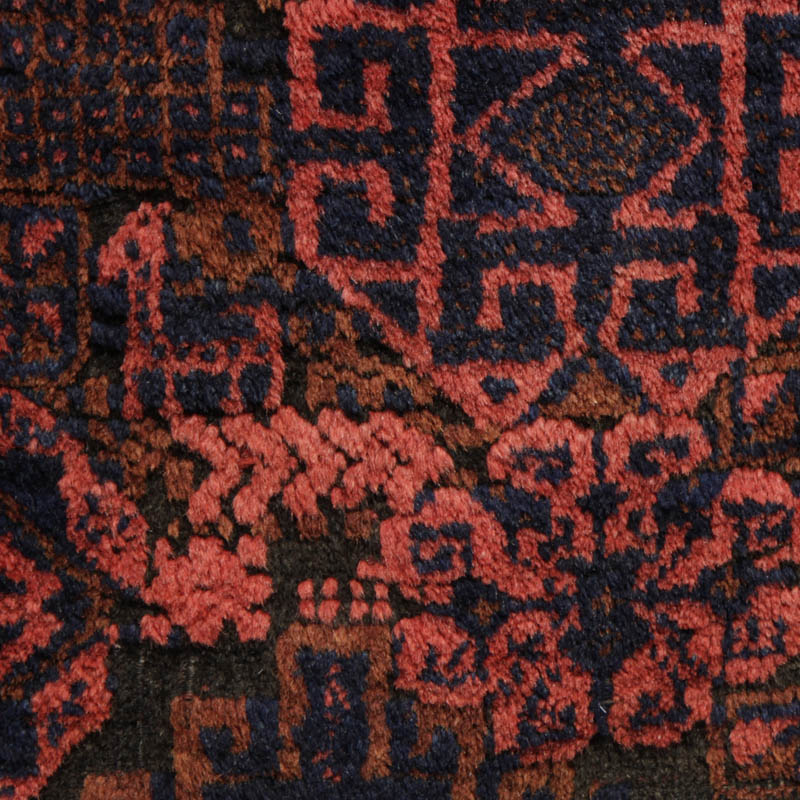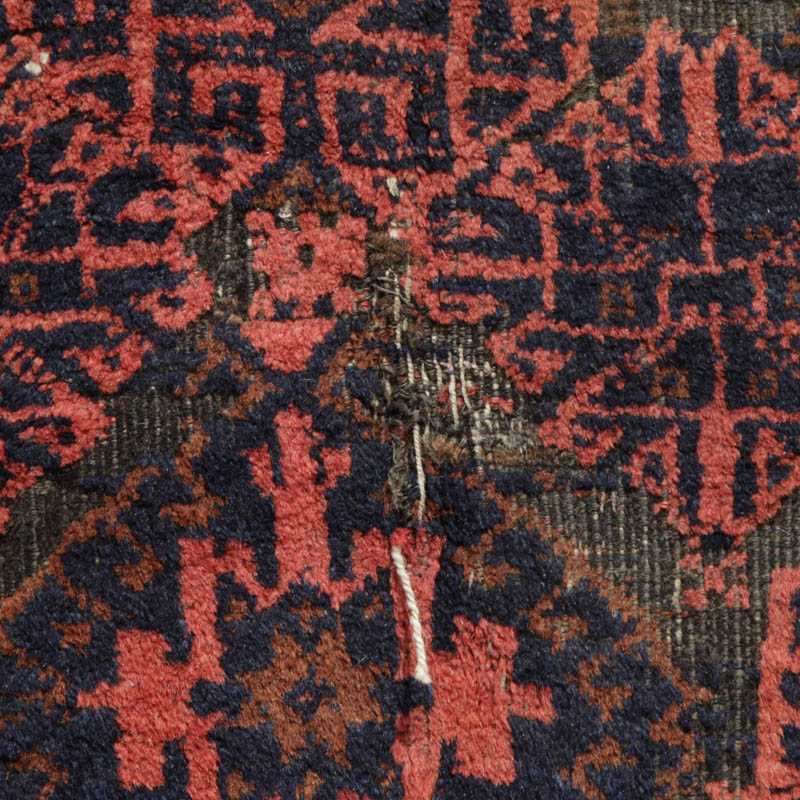Click on image to view in larger size.
See image in extra large size (opens jpg in same window) (2.8 MB).

The largish size and tightly woven structure with nearly fully depressed warps could point to a Herat workshop production. The pattern, however, is quite idiosyncratic and diverse, does not look at all like a rote design executed by a workshop employee. It is rather whimsical and shows little planning beyond some broad symmetry across the vertical axis. The design repertoire shows a wide range of design elements (see description in section 'Design' below). Drawing an Tom Cole's differentiation by colour (Baluch aesthetics), this Baluch type rug with its bluish red seems to fall into the Khorassan category; on the other hand, there is a lot of natural brown used, and the palette is very limited: madder red, very dark blue, dark brown (corroded) lots of medium brown (probably undyed wool), and very little ivory (only used for the thin guard borders flanking the main border on both sides). The dyes show very little, if any, abrash, which would again point to a (turn of the century, or later?) workshop origin.
It's hard to give a comprehensive account of the motifs and the way they compete in filling the large field: diamonds with hooked outlines and checkerboard fills, diamonds containing Kochak crosses (compare Stone's pattern B-12), variants of memling guls, divided squares, small blossoms, kirkbudak elements (compare Stone's pattern B-30), turkmen gul variants, eight-pointed stars, endless knot designs, etc. It looks a bit as if someone has emptied the entire Baluch pattern book onto the field of this rug. Empty space is filled up in an improvised manner with patterns or small animals.
The main border is considered rare by some writers — a recent discussion on Turkothek covers it in more detail and points to a particlular type of Turkmen jewellery (tumar) as its physical source.
The dimensions are 8.2 ft x 4.5 ft (251cm x 139cm). Tight, tensely ribbed back, weave nearly completely depressed, some unevenness in structure. Ivory wool warps, thin brown double wefts. (Still need to do the knot count : XX/10 cm vertical, XX/10 cm horizontal = XXXX knots per dm2. Translated into kpsi, this is about XX.v, XX.h = XXX kpsi.) The pile is good for red, blue, light brown, and white, down to knot bases (corroded) for dark brown. Nice and soft wool. The handle is firm and somewhat meaty with sufficient flexibility (not stiff).
A very limited palette of clearly all organic dyes: buish red madder, very dark indigo blue; medium brown, a very dark (corroded) brown and a bit of ivory white.
Structurally sound and complete. Good pile apart from corroded dark brown, which gives an embossed effect. In some areas of corroded brown ground, the white warps show (see images). The four-cord flat selvedges are in good shape, apart from about 5 inches at the top left which have become severed from the rug and need to be reconnected. One or two small superficial white stains in right border, a bit of wax (?) near the top left corner (see image). There is a short split (about 2 inches long) in the centre with no loss of material, just some wefts need to be threaded in. While not very dirty, the rug would benefit from a gentle wash.
All photos are taken in direct sunlight - compared to earlier attempts, it is now visible that the blues are truly dark blue and not black, and that the reds are well saturated and neither pinkish nor murky. Nothing more fiendish to photograph than a Baluch type rug. (I recommend staying 1-2 stops below the readings of your built-in light meter, and the colours may *just* look right (never completely).










Look at a fullsize photo of the back (opens in same browser window)




